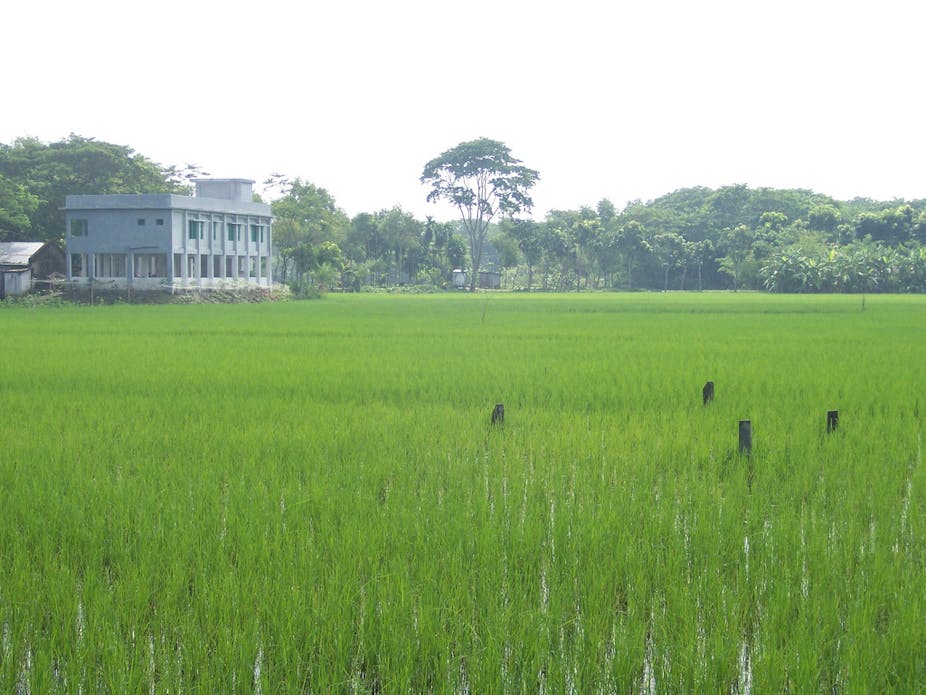Rice is the primary source of food for roughly half the world’s population. But it falls well short of providing enough iron, zinc and pro-vitamin A to meet daily nutritional requirements.
Iron deficiency is the most widespread nutritional disorder in the world, affecting more than two billion people. Symptoms include poor mental development, depressed immune function and anaemia.
To address this problem, scientists from the Australian Centre for Plant Functional Genomics (ACPFG) have produced rice with iron levels high enough to meet daily recommended requirements. This rice has up to four times more iron than conventional rice and twice as much zinc.
What’s surprising about this development is it doesn’t involve patented technology.
The iron rice instead uses very clever science to “trick” the rice into thinking it has insufficient iron so the rice absorbs a lot more iron from the soil than normal. It’s a bit like tricking a person into thinking they are hungry when they are not.
Gene patents are commonplace in agriculture. It’s now possible to improve plants by transferring genes from plant to plant. Genes can be turned on or off and made to work only in particular parts of a plant.
Why would anyone patent a gene?
The knowledge of genes and their function is a valuable tool to improve our food supply and quality. But gene patenting has been a contentious issue recently.
Proponents claim gene patentability is the key to recovering the huge investments required to improve crops and human health.
When someone takes out a patent in Australia, they’re given the right to use their idea, exclusively, for 20 years. After that, the knowledge becomes freely available.
This system encourages innovation and the generation of new ideas which have practical application. In the scheme of things, 20 years is a small piece of eternity.
The agricultural biotechnology industry uses the patent system in the developed world to recoup extensive research expenditure. Large companies such as Syngenta, BASF, DOW, Monsanto, DuPont and Bayer hold 63% of the patents in this area.
Without gene patents we would have less innovation, a solution that wouldn’t help food security at all.
How do we support food security in the developing world?
Companies that invent genetically manipulated crops want to make their money back. But there are alternatives to gene patents when we are making crops for the developing world.
In the case of the iron-enriched rice, the work was funded by the HarvestPlus program and the Australian Research Council. The former is a charitable organisation and the latter is funded by the Australian taxpayer. These organisations don’t expect to recoup their costs.
Also, iron deficiency is largely a problem of the developing world. We need to ensure the technology is made available to as many people as possible, at the lowest possible cost. There is little likelihood of recovering development funding under these circumstances.
In some cases, where new technologies are useful in the developed world as well as in developing nations, it may still be useful to patent those technologies. Such technologies can be licensed to seed companies in the developed world for commercial gain, whilst still providing the technologies “for free” elsewhere.
From developed to developing and back again
Patent ownership can also help stop “leakage” from the developing world into the developed world. By this I mean the developed world cannot gain, for no cost, technologies which they should pay for.
There are many instances where even patented technologies owned by large companies have been “donated” to the developing world. The Water Efficient Maize for Africa (WEMA) project is one such example.
In this case, Monsanto has donated drought-tolerant transgenes (developed with BASF) to the WEMA project with no expectation of royalties. This approach is commonplace, despite cries from some that multi-nationals are trying to control the food supply chain.
In some cases, organisations such as ACPFG – where I am General Manager – patent technologies in both the developing and the developed world.
Why do we do this? Well, it means we can control how technology is deployed. We can ensure that large companies don’t exploit our technology for commercial gain if we don’t want them to.
And of course we don’t want that to occur in the developing world.
The other reason we may wish to patent in the developing world relates to the length of time it takes to develop new technologies – ten years is not uncommon. In that time countries can transition from developing to developed.
ACPFG works with many of the research centres that help developing nations, such as CIMMYT in Mexico, and the International Rice Research Institute in the Phillipines.
In the developing world, we have a policy of making technologies freely available, whether patented or not. Even if we have a patent on a gene, we can provide a no-cost license in developing countries; many large companies do the same. This is a policy that continues in the case of high-iron rice.

